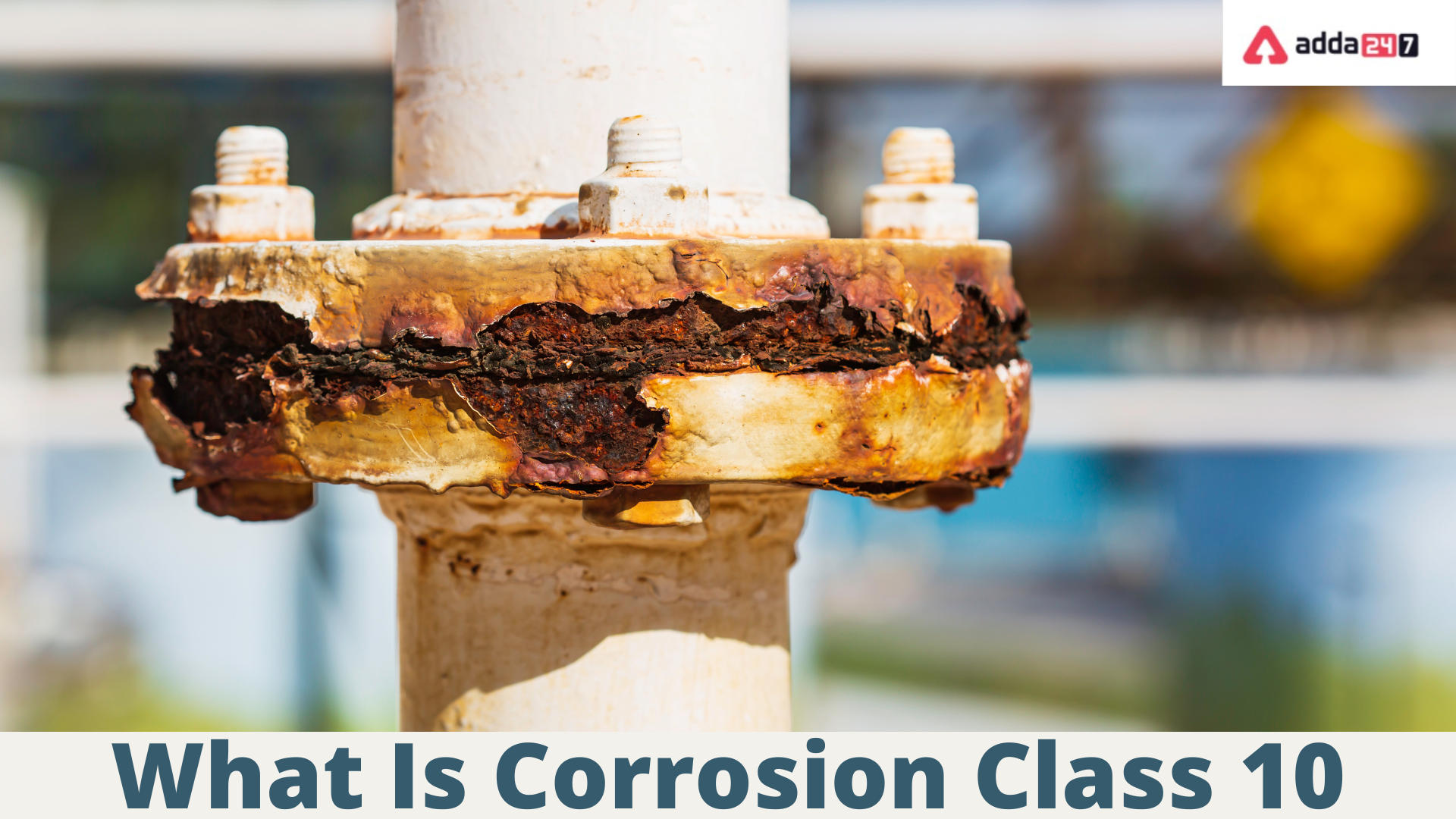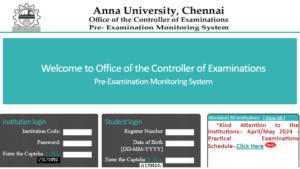Table of Contents
Corrosion
Corrosion is one of the most common phenomena that we observe in our daily lives. You must have noticed that some objects made of iron are covered with an orange or reddish-brown coloured layer at some point in time. The formation of this layer is the result of a chemical process known as rusting, which is a form of corrosion.
What Is Corrosion? in Chemistry
Cossorion, in general, is a process through which refined metals are converted into more stable compounds such as metal oxides, metal sulfides, or metal hydroxides. Likewise, the rusting of iron involves the formation of iron oxides via the action of atmospheric moisture and oxygen. If we look at the science behind corrosion then we can say that it is a spontaneous/ irreversible process wherein the metals turn into a much stable chemical compound like oxides, sulphides, hydroxides, etc. We shall delve deeper into the concept of corrosion and understand its different factors including its meaning, types, prevention and more in this lesson.
What Is Corrosion?- Definition
What is Corrosion?- It is basically defined as a natural process that causes the transformation of pure metals into undesirable substances when they react with substances like water or air. This reaction causes damage and disintegration of the metal starting from the portion of the metal exposed to the environment and spreading to the entire bulk of the metal.
Corrosion is usually an undesirable phenomenon since it negatively affects the desirable properties of the metal. For example, iron is known to have good tensile strength and rigidity (especially alloyed with a few other elements). However, when subjected to rusting, iron objects become brittle, flaky, and structurally unsound. On the other hand, corrosion is a diffusion-controlled process and it mostly occurs on exposed surfaces. Therefore, in some cases, attempts are made to reduce the activity of the exposed surface and increase a material’s corrosion resistance. Processes such as passivation and chromate conversion are used. However, some corrosion mechanisms are not always visible and they are even less predictable. Alternatively, corrosion can be classified as an electrochemical process since it usually involves redox reactions between the metal and certain atmospheric agents such as water, oxygen, sulphur dioxide, etc.
What Is Corrosion of Metals?
Metals placed higher in the reactivity series such as iron, zinc, etc. get corroded very easily and metals placed lower in the reactivity series like gold, platinum and palladium do not corrode. The explanation lies in the fact that corrosion involves the oxidation of metals. As we go down the reactivity series tendency to get oxidised is very low (oxidation potential is very low).
Interestingly, aluminium doesn’t corrode unlike other metals even though it is reactive. This is because aluminium is covered by a layer of aluminium oxide already. This layer of aluminium oxide protects it from further corrosion.
What Is Corrosion?- Factors Affecting Corrosion
- Exposure of the metals to air containing gases like CO2, SO2, SO3 etc.
- Exposure of metals to moisture especially salt water (which increases the rate of corrosion).
- Presence of impurities like salt (eg. NaCl).
- Temperature: An increase in temperature increases corrosion.
- Nature of the first layer of oxide formed: some oxides like Al2O3 forms an insoluble protecting layer that can prevent further corrosion. Others like rust easily crumble and expose the rest of the metal.
- Presence of acid in the atmosphere: acids can easily accelerate the process of corrosion.
What Is Corrosion Rate?
The Deal–Grove model is often used to describe the formation of an oxide layer. This model helps in predicting and controlling oxide layer formation in a lot of diverse situations. Alternatively, the weight loss method is also used to measure corrosion. In this method, a clean weighed piece of the metal or alloy is exposed to the corrosive environment for a certain duration. This is followed by a cleaning process that removes the corrosion products. The piece is then weighed in to determine the loss of weight.
The rate of corrosion (R) is calculated as;
R=kWρAt
Where,
k = constant,
W = weight loss of the metal in time t,
A = surface area of the metal exposed,
ρ is the density of the metal (in g/cm³).
What Is Corrosion?- Types
Some of the corrosion types include;
(i) Crevice Corrosion
Whenever there is a difference in ionic concentration between any two local areas of a metal, a localized form of corrosion know as crevice corrosion can occur. In a simple instance, this form of corrosion mostly occurs in confined spaces (crevices). Examples of areas where crevice corrosion can occur are gaskets, the undersurface of washers, and bolt heads. All grades of aluminium alloys and stainless steels also undergo crevice corrosion. This is mainly because of the formation of a differential aeration cell that leads to the formation of corrosion inside the crevices.
(ii) Stress Corrosion Cracking
Stress Corrosion Cracking can be abbreviated to ‘SCC’ and refers to the cracking of the metal as a result of the corrosive environment and the tensile tress placed on the metal. It often occurs at high temperatures.
Example: Stress corrosion cracking of austenitic stainless steel in chloride solution.
(iii) Intergranular Corrosion
Intergranular corrosion occurs due to the presence of impurities in the grain boundaries that separate the grain formed during the solidification of the metal alloy. It can also occur via the depletion or enrichment of the alloy at these grain boundaries.
Example: Aluminum-base alloys are affected by IGC.
(iv) Galvanic Corrosion
When there exists an electric contact between two metals that are electrochemically dissimilar and are in an electrolytic environment, galvanic corrosion can arise. It refers to the degradation of one of these metals at a joint or at a junction. A good example of this type of corrosion would be the degradation that occurs when copper, in a salt-water environment, comes in contact with steel.
Example: When aluminium and carbon steel are connected and immersed in seawater, aluminium corrodes faster and steel is protected.
(iv) Pitting Corrosion
Pitting Corrosion is very unpredictable and therefore is difficult to detect. It is considered one of the most dangerous types of corrosion. It occurs at a local point and proceeds with the formation of a corrosion cell surrounded by the normal metallic surface. Once this ‘Pit’ is formed, it continues to grow and can take various shapes. The pit slowly penetrates metal from the surface in a vertical direction, eventually leading to structural failure it left unchecked.
Example: Consider a droplet of water on a steel surface, pitting will initiate at the centre of the water droplet (anodic site).
(v) Uniform Corrosion
This is considered the most common form of corrosion wherein an attack on the surface of the metal is executed by the atmosphere. The extent of the corrosion is easily discernible. This type of corrosion has a relatively low impact on the performance of the material.
Example: A piece of zinc and steel immersed in dilute sulphuric acid would usually dissolve over its entire surface at a constant rate.
(vi) Hydrogen Grooving
This is a corrosion of the piping by grooves that are formed due to the interaction of a corrosive agent, corroded pipe constituents, and hydrogen gas bubbles. The bubbles usually remove the protective coating once it comes in contact with the material.
(vii) Metal Dusting
Metal dusting is a damaging form of corrosion that occurs when vulnerable materials are exposed to certain environments with high carbon activities including synthesis gas. The corrosion results in the break-up of bulk metal to metal powder. Corrosion occurs as a graphite layer is deposited on the surface of the metals from carbon monoxide (CO) in the vapour phase. This graphite layer then goes on to form meta-stable M3C species (where M is the metal) that usually moves away from the metal surface. In some cases, no M3C species may be observed. This means that the metal atoms have been directly transferred into the graphite layer.
(viii) Microbial Corrosion
Microbial corrosion which is also known as microbiologically influenced corrosion (MIC), is a type of corrosion that is caused by microorganisms. The most common one is chemoautotrophs. Both metallic and non-metallic materials either in the presence or absence of oxygen can be affected by this corrosion.
(viii) High-temperature Corrosion
High-temperature corrosion as the name suggests is a type of corrosion of materials (mostly metals) due to heating. Chemical deterioration of metal can occur due to a hot atmosphere that contains gases such as oxygen, sulfur, or other compounds. These compounds are capable of oxidizing the materials (metals in this case) easily. For example, materials used in car engines have to resist sustained periods at high temperatures during which they can be affected by an atmosphere containing corrosive products of combustion.
What Is Corrosion in Iron is Called Rusting?
Corrosion of elemental iron and its alloys, such as steel, is known as rusting. Corrosion can have a varying degree of effect on a lot of things. As such, it mainly causes waste of natural resources. Additionally, it can further cause hazardous situations such as building structures becoming weak and unstable, accidents caused by corroded parts as well as other unwanted failures such as cracked pipelines, bridge collapsing, transport vehicle crashes or other catastrophes. It is therefore important to check and prevent corrosion at all costs.
Prevention of Corrosion
Preventing corrosion is of utmost importance in order to avoid huge losses. The majority of the structures that we see and use are made out of metals. This includes bridges, automobiles, machinery, household goods like window grills, doors, railway lines, etc. While this is a concerning issue, several treatments are used to slow or prevent corrosion damage to metallic objects. This is especially done to those materials that are frequently exposed to the weather, saltwater, acids, or other hostile environments. Some of the popular methods to prevent corrosion include;
- Electroplating
- Galvanization
- Anodization
- Passivation
- Biofilm Coatings
- Anti-Corrosion Protective Coatings
- Painting and Greasing
- Use of Corrosion Inhibitor or drying agents
- Periodic cleaning of metal surface
Found this article helpful?
Reach us by means of visit or call our senior instructor at +91-9625869989 to figure out additional information about the various choices and streams that are open.
We would really see the value in it on the off chance that you could grant a portion of your insight. By utilizing our application, tests, and YouTube class help, you can unwind any vulnerability assuming that you’re centered around getting the best grades Adda247



 NTA NEET Exam Date 2025 OUT, Exam Timing...
NTA NEET Exam Date 2025 OUT, Exam Timing...
 NEET Admit Card 2025 Release Date by NTA
NEET Admit Card 2025 Release Date by NTA
 Anna University Result 2025 OUT at coe1....
Anna University Result 2025 OUT at coe1....










